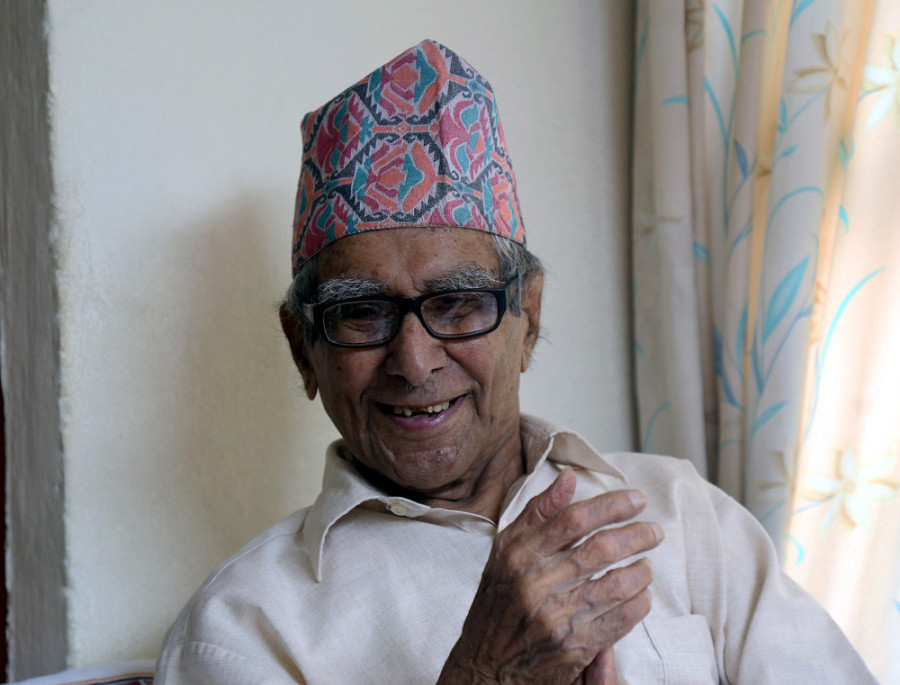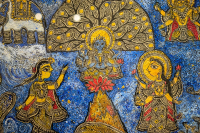Culture & Lifestyle
Madhav Prasad Ghimire, the Rastra Kavi, dies at 101
Known for his literary works such as Gauri (epic), Kinnar Kinnari (lyrical anthology), Charu Charcha (essay collection) and Shakuntala (epic), the poet of late was working on Ritambhara.
Timothy Aryal & Srizu Bajracharya
Madhav Prasad Ghimire, who has died aged 101, was one of the last of the Nepali literary figures from among the older generation. Known as Rastra Kavi, or national poet, Ghimire was also a playwright and essayist.
Ghimire died at his residence in Lainchaur on Tuesday evening.
He is best known for his literary works such as Gauri (epic), Kinnar Kinnari (lyrical anthology), Charu Charcha (essay collection) and Shakuntala, yet another epic.
One of his most popular works is Malati Mangale. The musical drama was first staged in 1985 to widespread national and international acclaim and continues to get staged even today.
“He was a humble and friendly person. His poems are simple and in the meantime deep and evocative,” said Satya Mohan Joshi, the centenarian historian and cultural expert. “His poems carried emotion and values.”
Though he dabbled in plays and essays, Ghimire’s forte was chhanda poetry, a style of rhythmic poetry that has a fixed meter. Perhaps the most iconic of his works is the widely acclaimed Gauri, an epic ode on his late wife.
“He was shattered and grief-stricken when his first wife died and he wrote an eponymous elegy in her remembrance, full of pathos and emotions, which I think people will remember him for," said Abhi Subedi, a professor of English at Tribhuvan University, poet, playwright and linguist.
Subedi, who is also a columnist for the Post, has translated Ghimire’s works into English.
Ghimire was born on September 23, 1919 at Putsun in Lamjung district. Later, he moved to Duradanda village to pursue further studies in Sanskrit. As a child, he was very studious, he’s said, and it didn’t take him long to publish his first literary work.
His first literary work, Bairagya Pushpa, was published in the Gorkhapatra daily when he was just 14.
The demise of Ghimire has created “a huge void”, said poet Viplob Pratik, who has published two anthologies of poetry.
“There are various subgenres in Nepali poetry, but the most disciplined of them is the chhanda,” Pratik told the Post. “If one grasps the rules of the chhanda, its meter, one can write a poem. But more often than not, such poems have no soul in them. In our canon, only three or four poets could infuse their chhanda poetry with soul. Ghimire certainly was one of them.”
Among his best known poems are Nepali Hami Rahaula Kaha, Gaauchha Geeta Nepali, Himal Pari Himal Wari, and Baisakh.
In their essence, the poems revolved around the themes of patriotism and the beauty of nature.
An entire generation of Nepalis grew up with the poem Gaauchha Geeta Nepali, which was included in school textbooks, where he talks about Nepal and Nepalis thus:
Gaucha geet Nepali
Jyoti ko pankha uchali
Jaya jaya jaya Nepal
Sundar shanta bishal
According to Subedi, as a poet, Ghimire came from a romantic school of thought and was a contemporary follower of Mahakavi Laxmi Prasad Devkota’s work and he wrote in the same vein as Devkota.
“He has written patriotic poems, poems about the Himalayas, about the love between a man and a woman, and poems for children,” said Subedi. “He was a great classicist of the Sanskrit school of thought and a true poet.”
Cultural expert Joshi, who turned 101 on May 12, is one of Ghimire’s contemporaries.
‘A modern romanticist’ is how Joshi described Ghimire.
“I believe his contribution is on par with the giants in Nepali literature like Bhanubhakta Acharya and Lekhnath Paudyal,” said Joshi.
Ghimire also wrote songs—some of them quite popular, including “Aajai ra raati ke dekkhe sapana mai mari gayeko” (I wonder what a dream I had in the night that I had died).
During his lifetime, Ghimire also held various public positions.
In 1946, he was appointed the editor of the state-owned Gorkhapatra daily. From 1988 to 1990, he served as the chancellor of the Royal Nepal Academy—now known as Nepal Academy.
The title of Rashtra Kavi was conferred on him by the government of Nepal in 2003.
Of late, Ghimire had been working on Ritambhara, which would be his another epic.
“I think the greatest loss for Nepali literature will be not getting to know the last mahakavya (epic poem) Ritambhara that he was working on, or maybe he has completed it,” said Joshi.
In 2018, Ghimire told the Post that he only has to get through the last two cantos of the epic.
“I write if I can, I don’t oblige, or try too hard,” he said. “There’s no point in trying too hard.”
He did not consider living long as a feat.
“If you live long, you also have to be able to give back to society,” he said. “Only then can you die in peace.”




 6.35°C Kathmandu
6.35°C Kathmandu
















